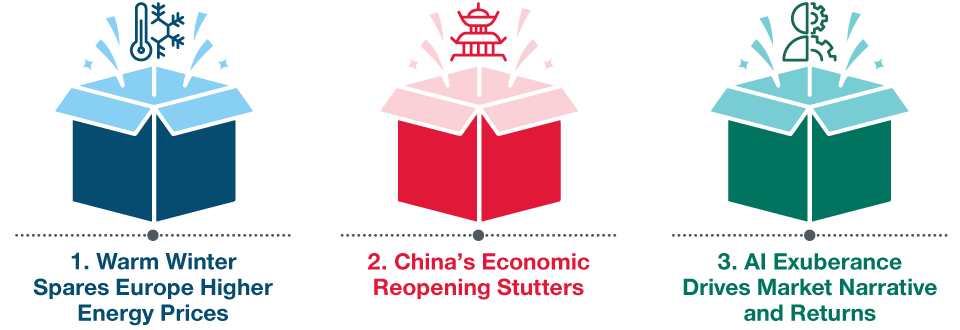Key points
- Geopolitical concerns and the need for supply chain independence will require investors to identify which companies and regions will win from this realignment.
- We continue to look for quality companies in which we have insights into improving economic returns, while not paying too much for them.
- The portfolio is balanced across sectors and factors, with the goal of maximizing capture ratio, hedging exogenous geopolitical shocks while allowing us to still focus on idiosyncratic stock picking.
There have been three key surprises in 2023. First, a warm winter spared Europe with energy prices going from an icy headwind to a pleasant tailwind. Second, the Chinese economy proved less robust than investors expected as it emerged from its zero‑COVID policies. And finally, the artificial intelligence (AI) wave exploded into markets, with semiconductor company earnings driven higher by panicked spending from internet giants keen to be at the forefront of the AI revolution. We were positioned well for the third surprise.
Three Equity Market Surprises
(Fig. 1) Lower energy prices, a disappointing economic recovery in China, and AIexuberance pose challenges for investors
As of June 2023. Past performance is not a reliable indicator of future performance. For illustrative purposes only. Source: T. Rowe Price.
COVID Distortions Have Muddied the Water
The aspect of the COVID cycle that confounds top‑down thinkers the most is how US Federal Reserve (Fed) rate hikes have failed to inflict significant pain on the global economy. Fed hikes are always dangerous because they are a catalyst for synchronised economic slowdowns. Hikes can lead to "black ducks"—chances for unexpected crisis—that sometimes turn out to be "black swans," but not always. Rate hikes also tend to set credit cycles in motion that are contagious and bring economic subsectors and regions into a harmony of slowing sales, earnings, capex, and rising unemployment. No doubt, rising rates and the increased cost of capital will slow the global economy, but the questions are when, at what level will rates bite, and is there sufficient synchronization of a credit cycle to set off a major recession.
The twist of the COVID cycle is that consumers and businesses did a good job of "terming" out their debt through better mortgage and high yield bond refinancing. The flood of deposits that filled consumer and business bank accounts softened the shock of higher rates and have fended off crisis so far. Meanwhile, pandemic‑related supply chain and labor disruptions prevented companies from pursuing major fixed asset investments. Like a rich kid with a stubborn trustee, the money was kept safe and only moderately misspent on some cryptocurrency and exercise equipment. The result has been a lack of synchronization of "bad" things, continued strong employment trends, and a "too slow" bleed of excess savings. The bears have been frustrated by mistaking ducks for swans.
Need for Supply Chain Independence Will Extend Inflationary Forces
Geopolitical change has been a hallmark of the post‑COVID world, with the Russian invasion of Ukraine altering Europe's energy landscape. Meanwhile, the steady deterioration of the relationship between the US and China has led us off the efficient frontier for global markets in terms of logistics, labor, productivity, and capital investment. The US and China are tangibly focused on reshaping their worlds for a more competitive future, despite the bounty of the past 30 years of linked growth. It is virtually impossible to decouple the two giants anytime soon, but there is no doubt that the US is seeking to secure its supply chain—onshore or "friend shore"—and China wants to find ways to break the US's technological constraints. This will result in the need for new relationships that will require new investments. The key for equity investors will be identifying the companies and regions that can win from the realignment.
COVID money and geopolitical tensions have also acted to extend inflationary pressures, despite the fortuitous short‑term release valve of a slow China recovery and unexpectedly low energy prices. Sticky inflation will mean sticky interest rates, something the Fed has clearly signaled in describing a policy of higher rates for longer. This does not mean that we will not have short‑term periods of economic acceleration and deceleration, but—in general—interest rate cuts and a return to "secular stagnation" seem unlikely in the near term.
This post was funded by T. Rowe Price
Important Information
For professional clients only. Not for further distribution.
This material is being furnished for general informational purposes only. The material does not constitute or undertake to give advice of any nature, including fiduciary investment advice, and prospective investors are recommended to seek independent legal, financial and tax advice before making any investment decision. T. Rowe Price group of companies including T. Rowe Price Associates, Inc. and/or its affiliates receive revenue from T. Rowe Price investment products and services. Past performance is not a reliable indicator of future performance. The value of an investment and any income from it can go down as well as up. Investors may get back less than the amount invested.
The material does not constitute a distribution, an offer, an invitation, a personal or general recommendation or solicitation to sell or buy any securities in any jurisdiction or to conduct any particular investment activity. The material has not been reviewed by any regulatory authority in any jurisdiction.
Information and opinions presented have been obtained or derived from sources believed to be reliable and current; however, we cannot guarantee the sources' accuracy or completeness. There is no guarantee that any forecasts made will come to pass. The views contained herein are as of the date noted on the material and are subject to change without notice; these views may differ from those of other T. Rowe Price group companies and/or associates. Under no circumstances should the material, in whole or in part, be copied or redistributed without consent from T. Rowe Price.
The material is not intended for use by persons in jurisdictions which prohibit or restrict the distribution of the material and in certain countries the material is provided upon specific request.
It is not intended for distribution to retail investors in any jurisdiction.
This material is issued and approved by T. Rowe Price International Ltd, 60 Queen Victoria Street, London, EC4N 4TZ which is authorised and regulated by the UK Financial Conduct Authority. For Professional Clients only.
© 2023 T. Rowe Price. All rights reserved. T. ROWE PRICE, INVEST WITH CONFIDENCE, and the bighorn sheep design are, collectively and/or apart, trademarks or registered trademarks of T. Rowe Price Group, Inc.















